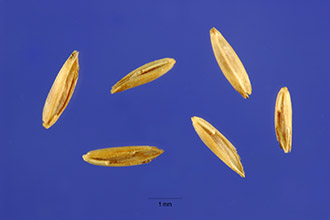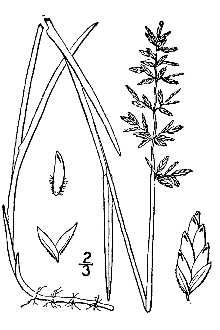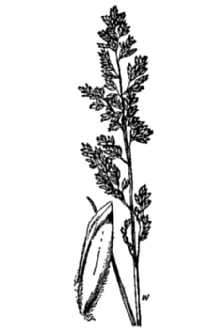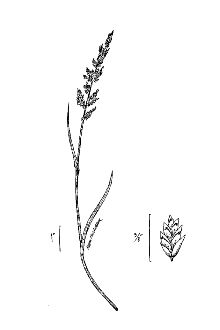Canada Bluegrass
Scientific Name: Poa compressa L.
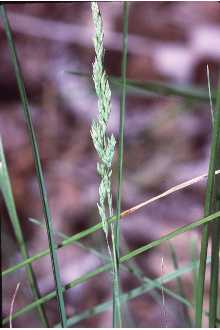
| General Information | |
|---|---|
| Usda Symbol | POCO |
| Group | Monocot |
| Life Cycle | Perennial |
| Growth Habits | Graminoid |
| Native Locations | POCO |
Plant Guide
Alternate Names
Common Alternate Names: English bluegrass, wiregrass, flat stem bluegrass
Uses
Canada bluegrass is a pioneer species on moderately acidic soils and on soils with poor fertility. Its primary use is for controlling erosion on disturbed sites such as roadsides, mine reclamation sites, heavy use recreation areas, and for low maintenance landscaping. It is palatable to livestock and big game but does not produce abundant forage. It stays green well into the fall and early winter (with adequate soil moisture) and withstands close grazing and heavy trampling. Small mammals and song birds consume leaves and seed. Prairie chickens, wild turkey, and cottontail rabbits eat small amounts of seed and leaves (Majerus and Holzworth, 2003; Uchytil, 1993). Mule deer browse Canada bluegrass in the winter.
Status
Canada bluegrass is listed as potentially invasive and banned in Connecticut (PLANTS Database). In Alaska, it does not appear to change species composition or structure in native plant communities (Klein, 2008). The spread of Canada bluegrass throughout North America is thought to have been caused by the contamination of Kentucky bluegrass (Poa pratensis) seed with Canada bluegrass. However, it was also found along the upper Saskatchewan River in Canada in 1823 and at other isolated locations unfrequented by European explorers in the early 1800’s (Oakley, 1910). Please consult the PLANTS Web site and your State Department of Natural Resources for this plant’s current status (e.g., threatened or endangered species, state noxious status, and wetland indicator values).
Weediness
This plant may become weedy or invasive in some regions or habitats and may displace desirable vegetation if not properly managed. Please consult with your local NRCS Field Office, Cooperative Extension Service office, state natural resource, or state agriculture department regarding its status and use. Weed information is also available from the PLANTS Web site at http://plants.usda.gov/. Please consult the Related Web Sites on the Plant Profile for this species for further information.
Description
General: Grass Family (Poaceae). Canada bluegrass is an introduced, perennial, rhizomatous grass. Culms are 15-20 cm (5.9-7.9 in) tall, hollow, flattened and glabrous to scaberulous. Sheaths are open, glaberous, smooth, or faintly scaberulous, flattened, and keeled. Leaves are 1-4 mm (0.04-0.16 in) wide and 2-10 cm (0.79-3.94 in) long, flat, folded or loosely involute, boat tipped, glabrous to scabrous and have two grooves down middle of upper blade surface. Collars are yellow, auricles absent and ligules are membranous, 0.5-1.5 mm (0.02-0.06 in) long, obtuse, ciliolate, and puberulent abaxially. The inflorescence is a narrow panicle 3-8 cm (1.18-3.15 in) long. Spikelets are 3to 8 flowered, 4-6 mm (0.16-0.24 in) long and crowded at the end of the branches. The first glume is 2-3 mm (0.08-0.12 in) long, acute and second glume is slightly longer and broader than the first.
Adaptation
Canada bluegrass is adapted to wet sites but thrives on moderately acidic, and droughty soils with poor fertility. It is found most commonly on clay textured soils and grows poorly on sandy textured soils (Oakley, 1910). It is best adapted to areas receiving at least 18 inches annual precipitation. Canada bluegrass low maintenance landscape planting at Bridger, MT Plant Materials Center. (Bridger, MT PMC)
Establishment
Seed should be planted into a clean, firm seedbed to a depth of ¼ inch. Drilling is preferred to ensure uniform seeding depth but broadcast seeding followed by harrowing and packing can be utilized where soil moisture is not lacking. Canada bluegrass can be slower to establish when broadcast seeded. Early spring seeding is preferred. Late summer (if soil moisture is adequate) and dormant fall seeding can be successful. The single species seeding rate is 2 pounds Pure Live Seed (PLS) per acre (Ogle, et al., 2011). For erosion control plantings, double the seeding rate to 4 pounds PLS per acre and for low maintenance turf plantings, sow 6 pounds PLS per acre. If planted in a mixture, adjust the seeding rate to the percent of mix desired. Seed weights reported range from 1,600,000 (Majerus and Holzworth 2003) to 2,393,000 (PLANTS Database) seeds per pound. Because seed is small, it is often seeded with a carrier such as rice hulls to facilitate more uniform distribution and metering of the seed. Stands may require weed control measures during establishment, but applications of broadleaf herbicides should not be made until plants have reached the four to six leaf stage. Mow above grass seedlings when weeds begin to bloom to reduce weed seed production. Insects may damage new stands and the use of insecticides may be required. Be sure to read and follow pesticide label directions.
Management
Canada bluegrass greens up early in the spring and if fall rains are adequate will make fall growth. Growth during summer is dependent on precipitation or irrigation. It stays green into late fall and early winter and is tolerant of close grazing and heavy trampling. Grazing should be deferred on seeded lands for at least two growing seasons to allow for full stand establishment.
Pests and Potential Problems
Grasshoppers, plant bugs, stink bugs, skipper caterpillars, moth caterpillars, beetles, and bluegrass billbugs feed on Canada bluegrass (Illinois Wildflowers, online). The only documented disease found in Canada bluegrass is oat necrotic mottle virus (ONMV) which causes a mosaic of oat and a mild or symptomless disease in Canada bluegrass and other grasses which might be transmitted by a mite (Gill, 1976).
Environmental Concerns
Concerns , Use soil moisture sensors to measure the soil moisture of Canada Bluegrass.
Concerns
Canada bluegrass spreads primarily by rhizomes. It is considered “weedy” by some and not so by others. Canada bluegrass may spread into adjoining plant communities under ideal climatic and environmental conditions. For alternatives to control Canada bluegrass contact your local agricultural extension specialist or county weed specialist to learn what works best in your area and how to use it safely. Always read label and safety instructions for each control method. Trade names and control measures appear in this document only to provide specific information. USDA NRCS does not guarantee or warranty the products and control methods named, and other products may be equally effective.
Seed and Plant Production
Plant Production
Plant Production
Canada bluegrass plugs are easy to propagate in a greenhouse. Seed is surface-grown into containers containing standard potting mix. Seeds germinate at temperatures between 20 and 30°C (68-86°F). Pre- chilling at 10°C (50°F) or alternating temperatures increases germination rates (Klein 2008). Approximately 60-90 days of growth are required before transplanting. Roots should fill containers but not be root-bound. Seed production fields can be established as a solid stand or in rows spaced 18-24 inches apart. Solid stands can be difficult to manage and should be attempted only with clean fields and confidence in chemical weed control. If planted in rows, the field can be allowed to go solid following two years of cultivation for weed control. Canada bluegrass seed matures uniformly and does not shatter readily making this species easy to harvest. It is ready to harvest when the field has reached a uniform golden color. Seed production fields may be swathed and combined out of a cured windrow or it may be direct harvested. Seed yields range from 250-500 pounds per acre on irrigated sites. Seed harvest occurs from mid July to mid August depending on location. Dryland seed production should not be attempted on sites receiving less than 18 inches annual precipitation (Majerus and Holzworth, 2003). Cultivars, Improved, and Selected Materials (and area of origin) ‘Canon’ was selected at Ontario Agricultural College, University of Guelph, Guelph, Ontario in 1944 from collections made in the United States and Canada. It was bred for leafiness and disease resistance. The intended use is for turf applications. Breeder seed is maintained by Ontario Agricultural College. Certified seed is apparently not available (USDA, 1994). Foothills Selected Class Germplasm was selected and released by the USDA-NRCS Bridger, Montana Plant Materials Center in 2001. It is a composite of eight collections from Europe (Denmark, Romania, Netherlands, and Czechoslovakia), Asia (former USSR), and the United States. It was selected for seedling vigor, rate of spread, forage production, seed production, and uniform ripening. It was tested with comparison to ‘Reubens’ and found to have superior seedling vigor, rate of spread, and seed production. Bridger Plant Materials Center maintains Generation 1 (G1) seed which is made available to seed growers for production of Certified G2 and G3 seed (Majerus and Holzworth, 2003). ‘Reubens’ was released by the Jacklin Seed Company, Post Falls, Idaho in 1976. It was a phenotypic selection of plants from an established field of common Canada bluegrass near Reubens, Idaho. Phenotypic selection was repeated in subsequent generations to improve trueness to type prior to release. Under a low maintenance mowing schedule, it becomes a denser turf than common Canada bluegrass. Breeder Seed is maintained by the Jacklin Seed Company and Certified seed is available (USDA, 1994). ‘Talon’ was developed by Cascade International Seed Company at its breeding facility located in Aumsville, Oregon. It originated as a single, apomictic plant selected from a controlled hybridization. The maternal parent was from a naturalized selection collected near Spokane, Washington in 1991. Paternal sources were also naturalized selections collected in 1991 near Spokane, Enterprise, Oregon and East Lansing, Michigan. Talon is unique from its maternal parent by its apomixis, taller and more erect growth habit, darker color and thicker stems. It is recommended for use in western Oregon and similar climates. The first Breeder seed was produced in 1995. Breeder and Certified Seed are maintained by L&H Seeds, Connell, Washington (AOSCA, 2010).
References
Association of Official Seed Certifying Agencies (AOSCA). 2010. A report of the National Grass Variety Review Board. May, 2010. [Online]. http://www.aosca.org/VarietyReviewBoards/Grass/2010GrassReport_final.pdf (accessed January 12, 2012) Gill, C. Oat necrotic mottle virus. [Online]. Descriptions of Plant Viruses. http://www.dpvweb.net/dpv/showadpv.php?dvno=169 (accessed January 9, 2012) Illinois Wildflowers. Canada bluegrass. [Online]. http://www.illinoiswildfloweres.info/grasses/cn_bluegrass.htm (accessed January 9, 2012). Klein, H. 2008. Canada Bluegrass (Poa compressa). [Online]. Alaska Natural Heritage Program, University of Alaska. http://aknhp.uaa.alaska.edu (accessed January 4, 2012). Majerus, M. 2009. Forage and Reclamation Grasses of the Northern Plains and Rocky Mountains. Valley Printers, Bridger, MT 161 p. Majerus, M, Holzworth, L. 2003. Foothills Selected Class Germplasm Canada Bluegrass A
Conservation
Plant for Montana and Wyoming. Fact Sheet. USDA -Natural Resources Conservation Service. Bozeman, MT. 2p Ogle, D., L. St. John, M. Stannard, L. Holzworth. 2011. Conservation Plant Materials for the Intermountain West. Technical Note 24. USDA-Natural Resources Conservation Service. Boise, ID. 57 p. Oakley, R. 1910. Canada Bluegrass: Its Culture and Uses. U.S. Department of Agriculture, Bureau of Plant Industry. Farmers Bulletin No. 402. 19 p. PLANTS Database. Poa compressa. [Online]. http://plants.usda.gov U.S. Department of Agriculture, Natural Resources Conservation Service. (accessed January 4, 2012) Skinner, Q. 2010. A Field Guide to Wyoming Grasses. Education Resources Publishing, Cumming GA. 595 p. Uchytil, R. 1993. Poa compressa. In
Plant Traits
Growth Requirements
| CaCO3 Tolerance | Medium |
|---|---|
| Frost Free Days, Minimum | 90 |
| Frost Free Days, Minimum | 130 |
| Frost Free Days, Minimum | 130 |
| Fire Tolerance | Low |
| Fire Tolerance | High |
| Fire Tolerance | High |
| Fertility Requirement | Low |
| Fertility Requirement | Low |
| Fertility Requirement | Low |
| Drought Tolerance | Medium |
| Drought Tolerance | Medium |
| Drought Tolerance | Medium |
| Cold Stratification Required | No |
| Cold Stratification Required | No |
| Cold Stratification Required | No |
| Temperature, Minimum (°F) | -38 |
| CaCO3 Tolerance | Medium |
| CaCO3 Tolerance | Medium |
| Anaerobic Tolerance | None |
| Anaerobic Tolerance | None |
| Anaerobic Tolerance | None |
| Adapted to Medium Textured Soils | Yes |
| Adapted to Medium Textured Soils | Yes |
| Adapted to Medium Textured Soils | Yes |
| Adapted to Fine Textured Soils | Yes |
| Adapted to Fine Textured Soils | Yes |
| Adapted to Fine Textured Soils | Yes |
| Adapted to Coarse Textured Soils | Yes |
| Adapted to Coarse Textured Soils | Yes |
| Adapted to Coarse Textured Soils | Yes |
| Hedge Tolerance | None |
| Temperature, Minimum (°F) | -38 |
| Temperature, Minimum (°F) | -38 |
| Shade Tolerance | Tolerant |
| Shade Tolerance | Tolerant |
| Shade Tolerance | Tolerant |
| Salinity Tolerance | None |
| Salinity Tolerance | None |
| Salinity Tolerance | None |
| Root Depth, Minimum (inches) | 10 |
| Root Depth, Minimum (inches) | 10 |
| Root Depth, Minimum (inches) | 1 |
| Precipitation, Minimum | 20 |
| Precipitation, Minimum | 16 |
| Precipitation, Minimum | 12 |
| Precipitation, Maximum | 45 |
| Hedge Tolerance | None |
| Hedge Tolerance | None |
| Moisture Use | Medium |
| Moisture Use | Medium |
| Moisture Use | Medium |
| pH, Maximum | 7.0 |
| pH, Maximum | 7.0 |
| pH, Maximum | 7.0 |
| pH, Minimum | 5.0 |
| pH, Minimum | 5.0 |
| pH, Minimum | 5.0 |
| Precipitation, Maximum | 45 |
| Precipitation, Maximum | 45 |
Morphology/Physiology
| Active Growth Period | Spring |
|---|---|
| Toxicity | None |
| Toxicity | None |
| Toxicity | None |
| Shape and Orientation | Semi-Erect |
| Shape and Orientation | Semi-Erect |
| Shape and Orientation | Erect |
| Resprout Ability | No |
| Resprout Ability | No |
| Flower Conspicuous | No |
| Fall Conspicuous | No |
| Fire Resistant | No |
| Fire Resistant | No |
| Fire Resistant | No |
| Flower Color | Yellow |
| Flower Color | Yellow |
| Flower Color | Yellow |
| Flower Conspicuous | No |
| Fall Conspicuous | No |
| Flower Conspicuous | No |
| Foliage Color | Gray-Green |
| Foliage Color | Gray-Green |
| Foliage Color | Green |
| Foliage Porosity Summer | Moderate |
| Foliage Porosity Summer | Moderate |
| Foliage Porosity Summer | Moderate |
| Foliage Porosity Winter | Porous |
| Bloat | None |
| Resprout Ability | No |
| Active Growth Period | Spring |
| Active Growth Period | Spring |
| After Harvest Regrowth Rate | Moderate |
| After Harvest Regrowth Rate | Moderate |
| After Harvest Regrowth Rate | Moderate |
| Bloat | None |
| Bloat | None |
| Nitrogen Fixation | None |
| C:N Ratio | Medium |
| C:N Ratio | Medium |
| C:N Ratio | Medium |
| Coppice Potential | No |
| Coppice Potential | No |
| Coppice Potential | No |
| Fall Conspicuous | No |
| Lifespan | Moderate |
| Height, Mature (feet) | 2.0 |
| Height, Mature (feet) | 2.0 |
| Known Allelopath | No |
| Known Allelopath | No |
| Known Allelopath | No |
| Leaf Retention | No |
| Leaf Retention | No |
| Leaf Retention | No |
| Foliage Porosity Winter | Porous |
| Lifespan | Moderate |
| Lifespan | Moderate |
| Low Growing Grass | Yes |
| Low Growing Grass | Yes |
| Low Growing Grass | Yes |
| Nitrogen Fixation | None |
| Nitrogen Fixation | None |
| Growth Rate | Rapid |
| Height, Mature (feet) | 2.0 |
| Foliage Porosity Winter | Porous |
| Foliage Texture | Fine |
| Foliage Texture | Fine |
| Foliage Texture | Fine |
| Fruit/Seed Color | Brown |
| Fruit/Seed Color | Brown |
| Fruit/Seed Color | Brown |
| Fruit/Seed Conspicuous | No |
| Fruit/Seed Conspicuous | No |
| Growth Form | Rhizomatous |
| Growth Form | Rhizomatous |
| Growth Form | Rhizomatous |
| Growth Rate | Moderate |
| Growth Rate | Rapid |
| Fruit/Seed Conspicuous | No |
Reproduction
| Fruit/Seed Persistence | No |
|---|---|
| Propagated by Tubers | No |
| Propagated by Tubers | No |
| Propagated by Tubers | No |
| Propagated by Sprigs | No |
| Propagated by Sprigs | No |
| Propagated by Sprigs | No |
| Propagated by Sod | No |
| Propagated by Sod | No |
| Propagated by Sod | No |
| Propagated by Seed | Yes |
| Propagated by Seed | Yes |
| Propagated by Seed | Yes |
| Propagated by Cuttings | No |
| Propagated by Cuttings | No |
| Seed per Pound | 2392820 |
| Seed per Pound | 2392820 |
| Seed per Pound | 2392820 |
| Seed Spread Rate | Slow |
| Seed Spread Rate | Slow |
| Seed Spread Rate | Slow |
| Seedling Vigor | Low |
| Seedling Vigor | Low |
| Seedling Vigor | Low |
| Small Grain | No |
| Small Grain | No |
| Small Grain | No |
| Vegetative Spread Rate | Slow |
| Vegetative Spread Rate | Slow |
| Vegetative Spread Rate | Slow |
| Propagated by Corm | No |
| Propagated by Cuttings | No |
| Bloom Period | Mid Spring |
| Bloom Period | Mid Spring |
| Bloom Period | Mid Spring |
| Commercial Availability | Routinely Available |
| Commercial Availability | Routinely Available |
| Commercial Availability | Routinely Available |
| Fruit/Seed Abundance | Medium |
| Fruit/Seed Abundance | Medium |
| Fruit/Seed Abundance | Medium |
| Fruit/Seed Period Begin | Spring |
| Fruit/Seed Period Begin | Spring |
| Fruit/Seed Period Begin | Spring |
| Fruit/Seed Period End | Summer |
| Fruit/Seed Period End | Summer |
| Fruit/Seed Persistence | No |
| Fruit/Seed Period End | Summer |
| Propagated by Corm | No |
| Propagated by Corm | No |
| Propagated by Container | No |
| Propagated by Container | No |
| Propagated by Container | No |
| Propagated by Bulb | No |
| Propagated by Bulb | No |
| Propagated by Bulb | No |
| Propagated by Bare Root | No |
| Propagated by Bare Root | No |
| Propagated by Bare Root | No |
| Fruit/Seed Persistence | No |
Suitability/Use
| Palatable Browse Animal | Medium |
|---|---|
| Palatable Graze Animal | High |
| Palatable Graze Animal | High |
| Palatable Graze Animal | High |
| Palatable Human | No |
| Palatable Human | No |
| Palatable Human | No |
| Post Product | No |
| Post Product | No |
| Post Product | No |
| Protein Potential | Medium |
| Protein Potential | Medium |
| Protein Potential | Medium |
| Pulpwood Product | No |
| Pulpwood Product | No |
| Pulpwood Product | No |
| Veneer Product | No |
| Veneer Product | No |
| Veneer Product | No |
| Lumber Product | No |
| Berry/Nut/Seed Product | No |
| Berry/Nut/Seed Product | No |
| Berry/Nut/Seed Product | No |
| Christmas Tree Product | No |
| Christmas Tree Product | No |
| Christmas Tree Product | No |
| Fodder Product | No |
| Fodder Product | No |
| Fodder Product | No |
| Palatable Browse Animal | Medium |
| Lumber Product | No |
| Lumber Product | No |
| Naval Store Product | No |
| Naval Store Product | No |
| Naval Store Product | No |
| Nursery Stock Product | No |
| Nursery Stock Product | No |
| Nursery Stock Product | No |
| Palatable Browse Animal | Medium |

